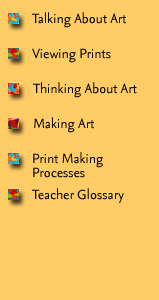
|

|
Home > Learning
Resources > Teacher's Packet >
Talking About Art
Talking About Art
Before
beginning the Chuck Close lesson and activities, talking about the following
areas provides a foundation for students to build their knowledge of art and
Chuck Close.
Ask the class if
they know about printmaking, and if they can think of different
types. Describe some of the various methods of printmaking and ask the
students to think about why an artist might choose to use this medium, as
opposed to drawing, painting or photography. Discuss some ways that
non-artists have used printmaking in the past and present, (books,
newspapers, currency, photocopy machines, newspaper printing, computer
printing, fingerprinting in law enforcement, etc.) and the difference
between printmaking as a fine art and as a commercial medium.
Talk about
portraits. Why would someone choose to paint a portrait of someone, or
even a portrait of themselves (a self-portrait)? Have students
think about what an artist might want to include in a portrait, and if and
when an artist might have to make the choice between faithful
representation of a subject, or a more flattering representation (omitting
certain things, emphasizing others, etc.)
-
Chuck Close
Chuck Close was born 1940 in Washington State and is renowned as one of
America’s foremost artists. He has been exploring the art of printmaking
as a part of his artistic inquiry for over 30 years. Chuck uses a grid to
transfer his subject from a photograph to a painting or print. By breaking
the larger image down into its smaller component parts, he is able to make
decisions about the nature and properties of the various colors that he
uses in his works. In his earlier works, Close was careful to hide the
grid upon completion, but in his later pieces, the grid has become a
visual element of the work itself, and is no longer simply for planning.
|


